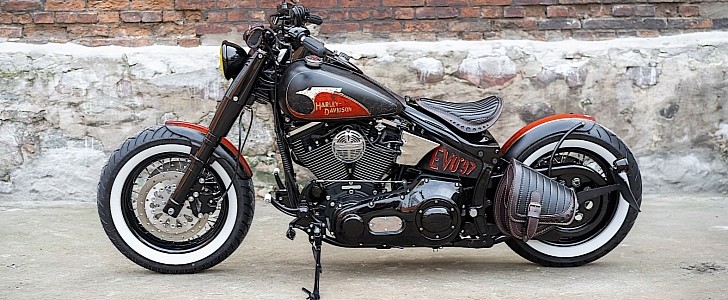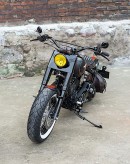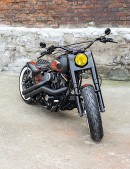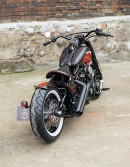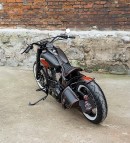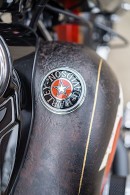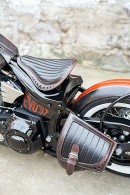There is probably not a single motorcycle ever made by Harley-Davidson that is not worthy (and suitable) of a worth-remembering remake. From the two-wheelers of the bike maker’s early years to the LiveWire that is supposed to represent its future, they all got their time under the spotlight as more or less great customs.
The brand is so powerful that there are probably more shops dedicated to it than to any other brand out there, no matter how many wheels the products they make have. Spread around the globe, these garages churn out Harley custom rides at a constant rate, providing us with plenty of opportunities for bewilderment.
Nine Hills Motorcycles is one of those shops. It comes from Poland, a country one would not usually associate with motorcycling, at least not in this form – but as often is the case, it’s such unassuming places that spill into the world two-wheeled wonders.
The bike we have here is one of the most mysterious builds we’ve ever covered, in that we haven’t got all that many details on exactly what went into its construction. We thought it would be a recomforting presence in our lives though, given how it’s based on a Harley-Davidson model that doesn’t cross our screens all that often.
The bike was initially a stock 1997 Heritage Softail, but now it looks as modern as any other Milwaukee machine out there, while at the same time retaining a certain vintage look. Nine Hills named it Lucifer.
Compared to its stock form, the Lucifer has a more aggressive stance thanks to the stripping of unnecessary elements and the addition of others. The wheels have been swapped with new hardware, wrapped in whitewall tires, and the large fenders are gone in favor of much slimmer ones.
The body design embraces a minimalist style, with a single rear wheel now exposed from underneath the saddlebags the bike originally came with, the front end boasts a simple fork adorned by a yellow headlight, and there’s a simple, single-seat behind the tank.
The motorcycle underwent a repaint that ended with the addition of what Nine Hills calls “hand-made patina,” and embellished with leather pieces here and there. We get a tri-color fuel tank, the words Nine Hills Motorcycles written on one side, and Evo ’97 on the other.
The biggest changes are though the ones we know nothing about. The shop speaks of quite radical modifications to the engine, which are supposed to give the thing a “predatory character”, but we’re left in the dark as to what exactly that means. We do know that the engine now breaths through a Vance & Hines exhaust system, but that’s about it.
Another thing Nine Hills doesn’t say is how much the bike cost to put together, but to give you a perspective on things, you should know a stock Heritage of that year sells used for under $10,000.
Nine Hills Motorcycles is one of those shops. It comes from Poland, a country one would not usually associate with motorcycling, at least not in this form – but as often is the case, it’s such unassuming places that spill into the world two-wheeled wonders.
The bike we have here is one of the most mysterious builds we’ve ever covered, in that we haven’t got all that many details on exactly what went into its construction. We thought it would be a recomforting presence in our lives though, given how it’s based on a Harley-Davidson model that doesn’t cross our screens all that often.
The bike was initially a stock 1997 Heritage Softail, but now it looks as modern as any other Milwaukee machine out there, while at the same time retaining a certain vintage look. Nine Hills named it Lucifer.
Compared to its stock form, the Lucifer has a more aggressive stance thanks to the stripping of unnecessary elements and the addition of others. The wheels have been swapped with new hardware, wrapped in whitewall tires, and the large fenders are gone in favor of much slimmer ones.
The body design embraces a minimalist style, with a single rear wheel now exposed from underneath the saddlebags the bike originally came with, the front end boasts a simple fork adorned by a yellow headlight, and there’s a simple, single-seat behind the tank.
The motorcycle underwent a repaint that ended with the addition of what Nine Hills calls “hand-made patina,” and embellished with leather pieces here and there. We get a tri-color fuel tank, the words Nine Hills Motorcycles written on one side, and Evo ’97 on the other.
The biggest changes are though the ones we know nothing about. The shop speaks of quite radical modifications to the engine, which are supposed to give the thing a “predatory character”, but we’re left in the dark as to what exactly that means. We do know that the engine now breaths through a Vance & Hines exhaust system, but that’s about it.
Another thing Nine Hills doesn’t say is how much the bike cost to put together, but to give you a perspective on things, you should know a stock Heritage of that year sells used for under $10,000.
